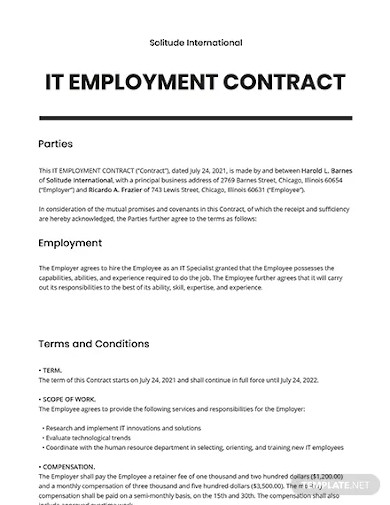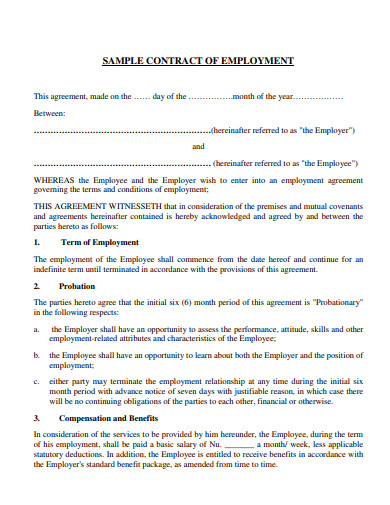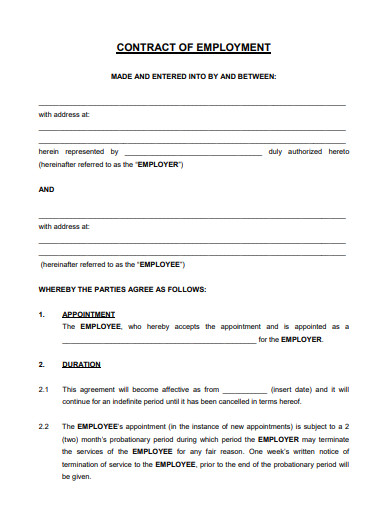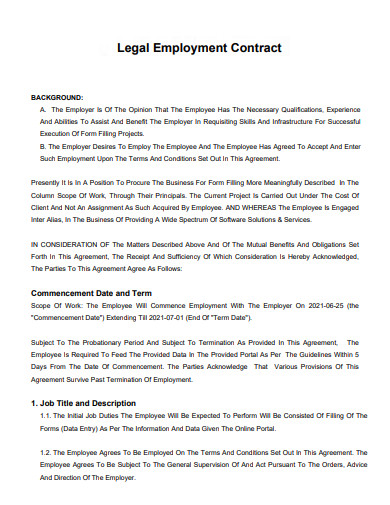Information technology jobs have been more prevalent in the job market since a lot of employers need them to work on computer systems and internet networks that require experts in that field to work on it. For employers hiring new IT employees to be part of their company, they need to create an employment contract before the employees will start their work. A contract is important as it signifies that the employee is legally hired by the company and they will also be aware of responsibilities expected of them and the compensation they will receive for their work. If you’re hiring IT professionals to work for your company, this article will guide you on how to make an IT employment contract.
4+ IT Employment Contract Samples
1. IT Employment Contract

2. Software Employment Contract

3. Sample IT Employment Contract
4. Consultancy IT Employment Contract
5. Legal IT Employment Contract
What is an Employment Contract?
An employment contract is a legal document that establishes the employment relationship between an employer and an employee. They have three forms: they can be verbal, in writing, or implied. In most IT-related work, written employment contracts are more common since they perform duties that are essential to the company that hired them.
Details to Include in an Employment Contract
An IT employment contract has similar terms and conditions to any other employment contract. Here are the details that you should include:
- Salary: Itemize the salary, and/or commission that the employer and employee agreed upon.
- General Responsibilities: List the different responsibilities and tasks that the IT employee is required to complete while employed in the company.
- Work schedule: Include the days and hours that the IT employee is expected to be present at work.
- Employment duration: Specify the length of stay that the IT employee agrees that they will work for the company. Their employment duration depends on what they agreed upon with the employer: they could be employed in a specific period or their employment is ongoing.
- Confidentiality: Since IT employees deal with network security, they also have access to sensitive information about the company or their clients that should be protected from outside sources. Include a statement about confidentiality and instructions that the IT employees are not allowed to divulge to any parties outside the company.
- Benefits: Lay out all the benefits that are promised to the employee such as health insurance, paid time off, retirement plans, and other perks that come with the job.
- Noncompete agreement: Include a non-compete agreement or clause that prohibits the IT employee from resigning and then taking a position from a company that competes with the current employer. This is optional to include in the contract.
FAQs
What are the different types of employment?
- Regular employees: They have full- or part-time employment in a company where they are directly hired to be part of the company’s workforce.
- Independent contractors: This arrangement is when an employer hires an independent freelancer or business to provide goods or services.
- Apprentices: An individual works under the direction of an experienced individual who teaches them the skills they need to learn to become licensed for a trade. This leans more towards blue-collar careers.
- Interns: This arrangement is when an individual work in a paid or unpaid position within a business for a short period to hone their skills. This leans more towards white-collar careers.
What are the different types of employment agreements?
- Written Contracts: A written contract defines the responsibilities, roles, and benefits that an employee has while working in a certain company. They are required to fulfill the terms of the contract while they are employed.
- Implied Contracts: An implied contract doesn’t necessarily have a written contract being made; instead it falls into place through a form of communication made during the interview process by providing a company handbook to the employee.
What is a trial period?
A trial period is when a new employee is hired in the company without the basis of any commitment between employer or employee which means they can resign from their job right away without having to go through a long and legal process of offboarding employees. There are no commitments yet between the employee and employer. This period is also called a probationary period.
What are the advantages of an employment contract?
There are a lot of advantages when a company provides employment contracts to their employees. Some of them are:
- They define the duties and benefits the employee has. It is also used by employers to set the standards as the basis for the employee’s performance.
- They protect both employers and employees of their rights. Employers can exercise their right to nondisclosure agreements and employees can also exercise their right to work in a safe workspace through dispute resolution clauses.
- They provide stability as they let both parties know what to expect from each other.
- They are legally binding so they have consequences when one of the parties breaks the contract.
- They attract employees because they promise job security compared to jobs without needing any contracts.
Once you’re done writing the contract, make sure to review it first and check to see if there are any errors or wrong information that you accidentally. Discuss it first with your employee and reach a mutual agreement with the contents of the contract before you both sign it. To help you get started making the contract, download our free sample templates above to use as your guide!
Related Posts
Sample Excuse Letter for School
Feature Writing Samples
FREE 10+ Security Guard Contract Samples in PDF | MS Word
FREE 10+ Option to Purchase Agreement Samples in MS Word | Apple Pages | PDF
FREE 26+ Curriculum Form Samples in MS Word | PDF
FREE 20+ Cleaning Service Proposal Samples in PDF | MS Word
FREE 29+ Sample Loan Application Form Templates in MS Word | PDF
FREE 10+ Event Venue Contract Samples in PDF | MS Word | Pages | Google Docs
FREE 10+ SBAR Samples in PDF | DOC
FREE 12+ Music Band Contract Templates in PDF | MS Word
FREE 10+ HVAC Maintenance Contract Samples in PDF | MS Word
FREE 10+ Social Media Marketing Contract Samples in MS Word | PDF
FREE 10+ Wholesale Assignment Contract Samples in PDF
FREE 18+ Financial Proposal Samples in PDF | MS Word | Google Docs | Pages
FREE 10+ Feasibility Study Samples in PDF



